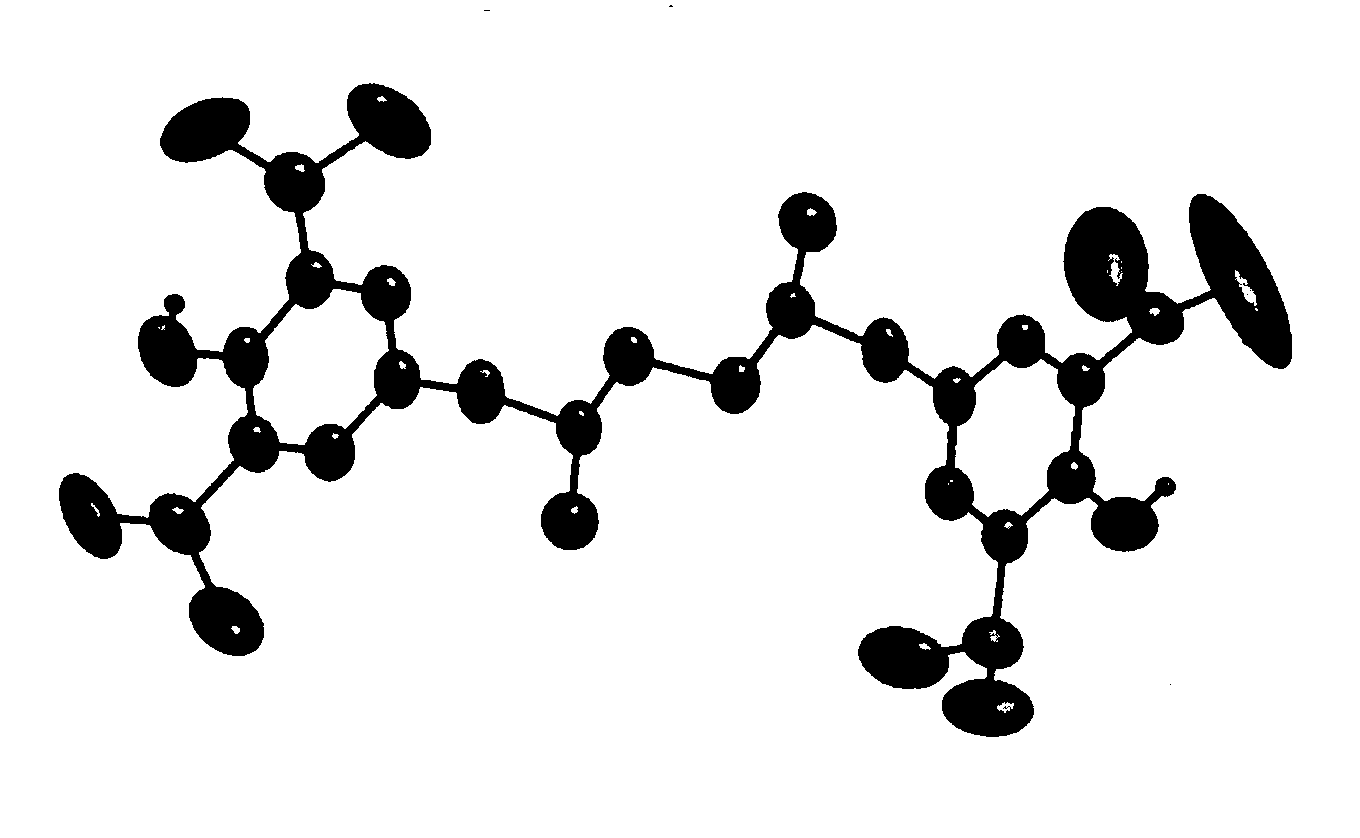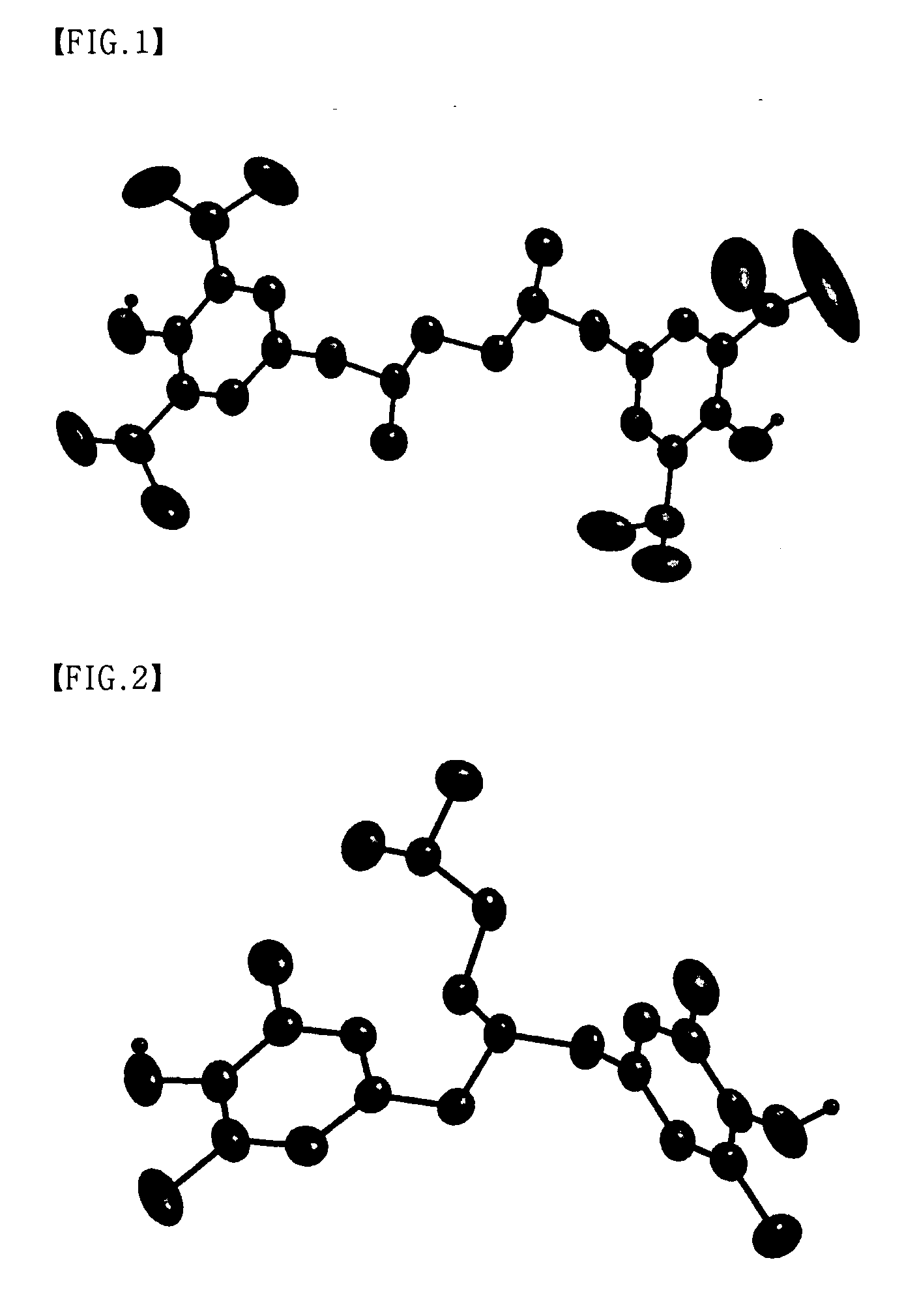Multinuclear half metallocene catalyst and method for preparing syndiotatic polystyren using the same
a multi-nuclear, metallocene technology, applied in chemical/physical processes, group 5/15 element organic compounds, group 4/14 element organic compounds, etc., can solve the problems of high production cost and difficulty in commercializing disclosed catalysts, and achieve high activity
- Summary
- Abstract
- Description
- Claims
- Application Information
AI Technical Summary
Benefits of technology
Problems solved by technology
Method used
Image
Examples
example 1
Synthesis of Catalyst 1
Preparation of ligand N{CH2Ph(3,5-i-Pr)2(4-OH)}3
[0064] 3.80 g (27 mmol) of hexamethylenetetramine, 23 ml (124 mmol) of 2.6-diisopropylphenol and 0.1 g of p-toluenesulfonic acid are put into a 100 ml Shlenk flask without solvent, and heated up to 110° C. As the temperature rises, solids are melted and homogenized, thereby turning into a dark brown solution. 12 hours later, 7 ml (37.8 mmol) of 2,6-diosoprppylphenol is trickled into a reaction vessel containing the dark brown solution using a syringe, and then reaction is continued for 12 hours more at 110° C. After the reaction is completed and the reaction vessel is cooled down to a room temperature, it is observed that the solution is turned into solid. The solid is dissolved in a small amount of acetone and then a solution in which all the solid is completely dissolved is maintained in a refrigerator to obtain colorless precipitate. Then, the solution is filtered and dried under vacuum, thereby obtaining 1...
example 2
Synthesis of Catalyst 2
[0066] 1.00 g (1.70 mmol) of the ligand N{CH2Ph(3,5-i-Pr)2(4-OH)}3 synthesized according to the example 1 method above is introduced into a 250 ml Shlenk flask and dissolved by 30 ml of diethylether, thereby obtaining a ligand solution. Then, the reaction vessel is lowered to −78° C. 2.2 ml (5.61 mmol) of normal butyl(n-BuLi, 2.5M solution hexane) is injected to the reaction vessel to be added to the ligand solution using a syringe and then the reaction vessel is gradually raised to a room temperature. The reaction solution is agitated for 4 hours, and then the reaction vessel is lowered to −78° C. again and a separate solution prepared by dissolving 5.61 mmol(1.62 g) of Cp*TiCl3 in 30 ml of diethylether using a cannula is added to the reaction solution in the reaction vessel. The solution mixture is agitated for 30 minutes, raised to a room temperature and then reagitated overnight. Solvent is removed from the reaction product in the reaction vessel under va...
example 3
Synthesis of Catalyst 3
Preparation of Ligand N{CH2Ph(3,5-Me)2(4-OH)}3
[0067] Ligand N{CH2Ph(3,5-Me)2(4-OH)}3 is prepared by the same method as in Example 1 except that 2,6-dimethylphenol is used instead of 2,6-diisopropylphenol. Yield 42%. 1H NMR (300.13 MHZ, CDCl3, ppm): δ=6.78(s, 6H, Ph-H), 4.46(br s, 3H, OH), 3.69(s, 6H, NCH2), 2.16 (s, 18H, Me). 13C{1H} NMR (75.47 MHz, CDCl3, ppm): δ=150.3(Ph), 133.4(Ph), 128.9(Ph), 122.9(Ph), 40.26(NCH2), 15.90 (Me).
Preparation of Cp*Ti(OMe)2[{(4-O) (3,5-Me)2PhCH2}3N] (Catalyst 3)
[0068] Catalyst 3, Cp*Ti(OMe)2[{(4-O) (3,5-Me)2PhCH2}3N] is prepared by the same method as to prepare the catalyst 1, Cp*Ti(OMe)2 [{(4-O) (3,5-i-Pr)2PhCH2}3N], as in Example 1 except that N{CH2Ph(3,5-Me)2(4-OH)}3 is used instead of N{CH2Ph(3,5-i-Pr)2(4-OH)}3. Yield 88%. 1H NMR (300.13 MHZ, CDCl3, ppm): δ=6.65(s, 6H, Ph-H), 3.96(s, 18H, OMe), 2.12(s, 6H, NCH2), 2.08(s, 18H, Me), 2.04(s, 45H, C5Me5). 13C{1H} NMR (75.47 MHz, CDCl3, ppm): δ=156.3(Ph), 128.2(Ph), 126.3...
PUM
| Property | Measurement | Unit |
|---|---|---|
| pressure | aaaaa | aaaaa |
| pressure | aaaaa | aaaaa |
| temperature | aaaaa | aaaaa |
Abstract
Description
Claims
Application Information
 Login to View More
Login to View More - R&D Engineer
- R&D Manager
- IP Professional
- Industry Leading Data Capabilities
- Powerful AI technology
- Patent DNA Extraction
Browse by: Latest US Patents, China's latest patents, Technical Efficacy Thesaurus, Application Domain, Technology Topic, Popular Technical Reports.
© 2024 PatSnap. All rights reserved.Legal|Privacy policy|Modern Slavery Act Transparency Statement|Sitemap|About US| Contact US: help@patsnap.com










